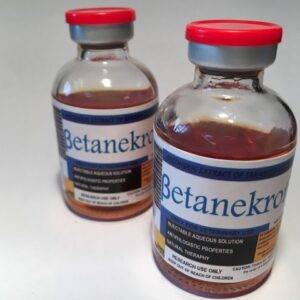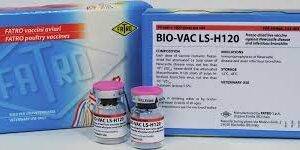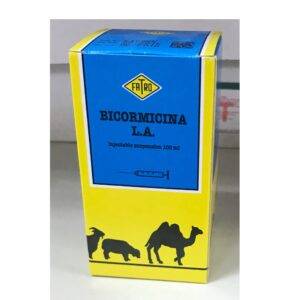Dexakel O2 Injection Solution
Dexakel O2 Injection Solution is a veterinary medication primarily containing Dexamethasone, a potent corticosteroid used for its anti-inflammatory, immunosuppressive, and anti-allergic properties. The “O2” in the name might suggest a specific formulation or combination of active ingredients, but Dexamethasone is the primary agent in treating inflammation and immune-mediated conditions in animals like horses, cattle, dogs, and cats.
Composition:
Dexamethasone: A synthetic corticosteroid that mimics the effects of cortisol, a natural hormone produced by the adrenal glands, and is known for its strong anti-inflammatory and immunosuppressive properties.
Other components in the formulation may vary depending on the manufacturer.
Key Uses in Horses and Other Animals:
Dexakel O2 Injection Solution is used to treat various inflammatory, allergic, and immune-mediated conditions in animals, making it useful in a wide range of clinical settings. Some of the key uses include:
Musculoskeletal Disorders: To treat joint, tendon, and muscle inflammation in conditions like arthritis, bursitis, or tendonitis.
Allergic Reactions: Provides fast relief for severe allergic reactions caused by insect bites, environmental allergens, or medications.
Respiratory Conditions: Helps manage chronic respiratory issues like Chronic Obstructive Pulmonary Disease (COPD) or “heaves” in horses by reducing inflammation in the airways.
Autoimmune Diseases: Used to suppress the overactive immune response in conditions such as autoimmune hemolytic anemia.
Skin Disorders: Useful in treating allergic dermatitis and other inflammatory skin conditions.
Shock and Trauma: Administered in emergency situations to stabilize animals in shock or trauma by controlling the body’s inflammatory response.
Eye Inflammation: Sometimes used in cases of severe eye inflammation like uveitis, to reduce swelling and discomfort.
Fever and Toxicity: Can be used as an adjunct therapy to reduce fever or manage toxicity by controlling the immune response.
Dexakel O2 Administration:
Form: Dexakel O2 is available as an injectable solution.
Dosage: The dosage varies based on the animal’s species, weight, and the severity of the condition being treated. The exact dosage should be determined by a veterinarian.
Route of Administration: It is administered via intramuscular (IM), intravenous (IV), or subcutaneous (SC) injection. The route of administration depends on the condition being treated and the urgency of the response required.
Mechanism of Action:
Dexamethasone, the active component in Dexakel O2, works by blocking the production of inflammatory mediators like prostaglandins and leukotrienes. It also stabilizes cell membranes and suppresses immune system activity, helping to reduce swelling, redness, and pain associated with inflammation. The drug is effective in managing autoimmune conditions by preventing the immune system from attacking the body’s own tissues.
Duration of Action:
The effects of Dexakel O2 typically begin within a few hours of administration, with the duration of action lasting from 12 to 36 hours, depending on the dose and condition being treated. For acute conditions, the response is rapid, but for chronic conditions, it may be part of a longer treatment regimen.
Side Effects:
Corticosteroids like Dexamethasone can have a range of side effects, especially with long-term or high-dose use:
Laminitis: A serious potential side effect in horses. Prolonged use of corticosteroids can trigger laminitis, a painful inflammation of the hoof tissue.
Suppressed Immune System: Prolonged use can weaken the immune system, making animals more susceptible to infections.
Delayed Wound Healing: Corticosteroids can interfere with the natural healing process, potentially delaying recovery from injuries or surgery.
Increased Thirst and Urination: Some animals may experience polydipsia (increased thirst) and polyuria (increased urination).
Gastrointestinal Issues: Prolonged use can increase the risk of gastric ulcers, colic, or other gastrointestinal complications.
Muscle Weakness: Long-term corticosteroid use can lead to muscle wasting and weakness.
Cushing’s Syndrome: Long-term use can cause symptoms of Cushing’s disease, which includes weight gain, muscle atrophy, and increased risk of infections.
Behavioral Changes: Some animals may become irritable or hyperactive due to the corticosteroid.
Precautions:
Short-Term Use: Dexakel O2 should typically be used for short-term treatments to minimize the risk of severe side effects like laminitis in horses or Cushing’s syndrome.
Pregnant Mares: Dexamethasone can induce premature labor or abortion, especially in late pregnancy. It should only be used with caution in pregnant mares under strict veterinary supervision.
Pre-existing Conditions: Horses or other animals with pre-existing conditions like metabolic disorders, infections, or ulcers should be monitored carefully or treated with alternative medications.
Gradual Tapering: If Dexakel O2 is used for an extended period, it should be tapered off slowly to avoid withdrawal symptoms or adrenal insufficiency, where the body is unable to produce adequate cortisol after stopping the medication abruptly.
Contraindications:
Systemic Infections: Dexakel O2 should not be used in animals with untreated systemic infections, as corticosteroids can weaken the immune system and worsen infections.
Hypersensitivity: Animals allergic to Dexamethasone or any other components in the formula should not receive this medication.
Monitoring:
Veterinary Checkups: Regular monitoring by a veterinarian is recommended, especially for animals receiving Dexakel O2 for extended periods. This includes checking for signs of laminitis in horses, infections, or gastrointestinal issues.
Blood Tests: Long-term use may require periodic blood work to monitor liver and kidney function, as corticosteroids can impact these organs.
Dexakel O2 Withdrawal Period:
For competitive animals or food-producing animals, a withdrawal period must be observed before they can participate in events or be slaughtered for human consumption. Each country has specific withdrawal guidelines, so it’s important to consult local regulations.
Differences Between Dexakel O2 and Other Dexamethasone Products:
Dexakel O2 vs. Dexafort, Dexacortyl, Dexadreson: These products all contain Dexamethasone, but their formulation and release profile may vary. Dexakel O2 may have a specific combination or formulation that distinguishes it from other Dexamethasone-based products, such as the rate of release or additional components.
Dexakel O2 vs. Dexa G Rapid: Unlike Dexa G Rapid, which combines Dexamethasone with Gentamicin (an antibiotic), Dexakel O2 appears to be focused on the corticosteroid properties without an antibiotic component.
Dexakel O2 Storage:
Dexakel O2 should be stored at room temperature, away from direct sunlight and protected from freezing. Follow the storage instructions on the label to ensure the medication remains effective.
Where to Buy Dexakel O2:
Dexakel O2 can be purchased through licensed veterinary clinics or authorized veterinary pharmacies. A veterinarian’s prescription is generally required due to the controlled nature of corticosteroids. Be sure to buy from reputable sources to ensure the product’s quality and authenticity.
Summary of Key Points:
Active Ingredient: Dexamethasone.
Uses: Treatment of inflammation, allergies, respiratory conditions, autoimmune disorders, and shock.
Administration: Injectable solution (IM, IV, or SC).
Side Effects: Risk of laminitis, immunosuppression, delayed healing, gastrointestinal problems, and Cushing’s syndrome.
Precautions: Short-term use is generally recommended; caution is advised in pregnant mares and animals with pre-existing conditions.
Monitoring: Regular veterinary checkups and blood tests may be necessary for long-term use.
Withdrawal Period: Required for competitive animals or those used in food production.





Reviews
There are no reviews yet.